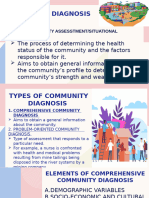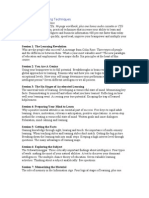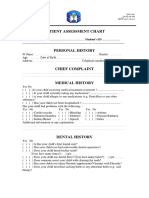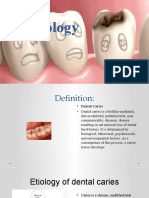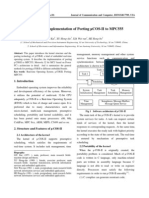0 ratings0% found this document useful (0 votes)
195 viewsOral Health Program
Uploaded by
api-233877887Copyright
© © All Rights Reserved
Available Formats
Download as DOCX, PDF, TXT or read online on Scribd
0 ratings0% found this document useful (0 votes)
195 viewsOral Health Program
Uploaded by
api-233877887Copyright
© © All Rights Reserved
Available Formats
Download as DOCX, PDF, TXT or read online on Scribd
You are on page 1/ 11
NEEDS ASSESSMENT
Courtney Cabra & Samantha Fukuda
A. General Date
1. Description of Site
C. O. Wilson Junior High School, operated by the Nederland Independent School district, is
located at 2620 Helena Ave. Nederland, Texas 77627. It was first established in September of
1958 and was named after a former superintendent, Carroll Oscar Wilson. C. O. Wilson
became a middle school in 1987 and is serving about 820 students in grades 5 through 8. Like
all public schools, C.O. Wilson is funded under all three levels of government federal, state,
and local. The main objective of this school is to provide a safe, orderly, trusting, and caring
environment in order to ensure that our students will meet and exceed a high level of academic
achievement as measured by state and national standards.
2. Description of Target population
The target population is a special needs science class which consists of adolescents between
the ages of 10 and 14. Currently there are 6 males and 4 females. Of these students 7 are white
and 3 are Hispanic. The decision to be placed in the special needs class is made by the parents
or the students legal guardians. This class focuses on the needs of students with learning
disabilities or special needs. Parent participation for these students is recommended to ensure
that the adolescent is receiving the greatest amount of assistance possible.
3. Description of Staff Population
The C.O. Wilson staff population for this organization is ran under Tina Oliver, the assistant
principle, and Laurie Frasier. Laurie Frasier, the core teacher, has a bachelor's degree and
spends every day teaching these students. She has been ahead of this program for over 20 years
now.
4. Description of Services Provided
The main service provided to these specific students is a special needs science class. When
the students are finished with their science class objectives, Mrs. Laurie Frasier also helps them
with other school work. Their daily routine consists of keeping weather journals, daily
assignments, vocabulary, videos related to lesson, health (not including oral care), and physical
exercise when the weather allows.
5. Other Pertinent Data
C.O. Wilsons water has been fluoridated by the Nederland community water system at an
optimal fluoride concentration level of 0.08 mg/L since January 1, 1967.
B. Information Related to Dental Health
This organization does not practice daily oral health nor does it provide any dental health
information to the special need students. When speaking to Laurie Frasier, she expressed much
excitement about introducing oral health to her students.
C. Dental Health Status
1. Dental Caries
Dental caries is one of the most common conditions affecting the general health of
adolescents. Adolescents with special needs have a higher risk for caries because of their diet,
xerostomia, difficulties performing oral hygiene, GERD, gingival hyperplasia and crowing of
the teeth and are generally twice as likely to not have their dental needs met.
2. Periodontal Disease
Periodontal disease is common in the special needs population as it can be caused by certain
medications as well as poor oral hygiene.
3. Malocclusion
Malocclusion and crowded teeth occur more often in children with special needs. Crowded
teeth are more difficult to clean, thereby increasing the risk of dental caries and periodontal
disease.
4. Oral Cancer
No significant findings.
5. Utilization of Dental Services
While children with special needs are at greater risk of developing oral health problems, they
also have higher levels of unmet need. There have been several barriers to providing care for
children with special needs. These include: office limitations to accommodate a special needs
child, scheduling complications, childrens behavioral problems, and few dentists with
appropriate training.
6. Additional Information
If a child has numerous medical concerns, families may consider oral health a low priority.
GOALS AND OBJECTIVES
1. The special needs children in C.O. Wilson's science class will increase their knowledge and
improve their overall oral health.
The teacher will begin to incorporate oral health care into her lesson plan.
Detect and recognize plaque in their mouth
Establish a daily oral health routine by demonstrating proper brushing and flossing.
Decrease plaque accumulation.
Identify healthier nutritional choices.
Describe the caries process.
RATIONALE FOR PROGRAM
In this lesson students will form an understanding of the concept of oral health. By
comprehending the concept, students will learn critical skills and knowledge necessary to
achieve oral health. This lesson plan shows our ability to incorporate subjects and resources to
meet different learner needs. The learning experiences and materials are appropriate to the
developmental level of the students and are appropriate to achieve our objectives. The lesson
also incorporates information for teacher presentation as well as for collaborative student
activities.
PROGRAM DESIGN
A. Activities
The program plan is aimed at educating the special needs class and teacher. The educational
sessions will consist of teaching basic dental health topics, oral hygiene practices, and the
importance of good oral health. The sessions will be performed on a weekly basis at the C.O.
Wilson middle school. These sessions will be developed in the following way:
Session 1 (week 1)
Plaque and proper brushing techniques.
1. Discover what the students know about plaque by giving them a short pre-test.
2. Provide information about plaque and brushing on handouts and in a PowerPoint
presentation.
3. Disclose the students oral cavity using disclosing tablets to assess the amount of plaque in
their mouth.
4. Present the students with proper brushing technique through demonstration and visual aids.
5.Provide each student with a new toothbrush and observe them while they perform their daily
brushing habits.
6. Allow the students to practice new brushing methods on typodont while we critique them.
7.Discuss the importance of good oral hygiene and how to implement daily plaque control
routines.
8. Review with students on the new information.
Session 2 (week 2)
Gingivitis and Flossing.
1. Review plaque and brushing by giving an oral pop quiz.
2. Give a presentation about gingivitis and proper flossing using a PowerPoint presentation and
visual aids.
3. Discover how many students floss daily by using a quick show of hands.
4. Explain the importance of flossing daily to the remove plaque.
5. Teach the students how to properly floss their teeth with the use of visual aids.
6. Allow the students to practice on the typodonts until they are comfortable enough to practice
in their own oral cavity
7. Observe the students perform new habits in their own oral cavity as we evaluate the and
assist when required.
8. Review information with a short test.
Session 3 (week 3)
Nutrition.
1. Review information from previous sessions with a review game.
2. Present nutritional information with a PowerPoint presentation and visual aids.
3. Make sure the students have a better understanding about nutritional choices with a quick
pop quiz.
Session 4 (week 4)
Caries.
1. Quiz the students on the information given over the past 4 weeks with a quick pop quiz.
2. Determine what the students know about caries and the caries process.
3. Provide information regarding the caries process to the students using visual aids.
4. Test the students at the end of session 5 over all of the information presented to them
throughout the entire health program with a written test.
5. Play a review game with the students.
B. Constraints and Alternative Strategies
1. Constraint: There may be a lack of interest on the part of the special needs students due to
the lack of life skills and their attitude towards their oral health.
Alternative: We will keep the presentation clear and interesting. We will include visual aids
such as charts, pictures, and videos in our presentation. We will ask questions frequently to
involve the students as much as possible.
2. Constraint: There may be a lack of coordination or dexterity when performing plaque control
procedures.
Alternative: We will include alternative methods for the students who lack coordination or
dexterity when it comes to oral health procedures.
3. Constraint: The students parents' may not enforce the newly learned oral health care
methods at the home setting.
Alternative: We will stress the importance of proper oral care at home and establish a daily
routine. (brushing and flossing 3 times daily)
4.Constraint: The special need students may not have adequate professional dental visits.
Alternative: We will stress to the significance of routine dental visits for the students overall
health. We will explain that their oral health is equally important compared to their other health
needs and that proper oral health can prevent further dental emergencies. We will also give the
parents information about the LIT Dental Hygiene Clinic.
C. Resources
Colgate is providing toothpaste, toothbrushes, and floss for our oral health program. We will
also be using disclosing tablets provided by our school, LIT. All other products needed for the
experiments in this oral health program will be provided by Courtney Cabra and Samantha
Fukuda.
D. Budget
The estimated cost for this oral health program is as follows:
1. Toothbrushes $0
2. Toothpaste $0
3. Floss $0
4. Disclosing tablets $0
5. Gloves $15
6. Masks $10
7. Napkins and cups $10
8. Syrup $5
9. Coloring pages $0
10. Games $5
11. Typodont $0
TOTAL ESTIMATE: $45
E. Timetable
For this oral health project all resources will be obtained before each session. We will be
providing five sessions over a five week period of time. The schedule of the oral health program
is as follows:
Session 1: Monday, March 24, 2014.
Session 2: Monday, March 31, 2014.
Session 3: Monday, April 7, 2014.
Session 4: Monday, April 14, 2014.
Session 5: Monday, April 21, 2014.
Each session in this oral health program will take approximately 45 minutes to one hour.
EVALUATION
A. As a formative evaluation we will be giving pop quiz's through each session to assure that
the students are obtaining the information. These quiz's will include multiple choice, true false,
and matching questions.
B. As a summative evaluation we will give one last quiz at the end of session 5 containing
information from each previous session. We will also play a review game with the students to
evaluate the amount of information they learned.
REFERENCES
Centers for Disease Control and Prevention. Centers for Disease Control and Prevention, 11 Mar. 2014.
Web. 17 Mar. 2014.
Centers for Disease Control and Prevention. Centers for Disease Control and Prevention, n.d. Web. 15
Mar. 2014.
"Dental Caries (Tooth Decay) in Adolescents (Age 12 to 19)." Dental Caries (Tooth Decay) in
Adolescents (Age 12 to 19). N.p., n.d. Web. 17 Mar. 2014.
Frasier, Laurie. "Special Needs Oral Health Program." Personal interview. Feb. 2014.
Oliver, Tina, Mrs. "Special Needs Oral Health Program." Personal interview. Feb. 2014.
"Oral Conditions in Children with Special Needs: A Guide for Health Care Providers." Oral Conditions in
Children with Special Needs: A Guide for Health Care Providers. N.p., n.d. Web. 17 Mar. 2014.
Dear Parents:
Throughout the next 5 weeks, will be providing an oral health program including various oral
hygiene activities. These activities are an integral part of the program and each students
participation is encouraged. Please review and sign the permission slip below and return it to
school. Feel free to contact us if you have any questions.
Sincerely,
Courtney Cabra and Samantha Fukuda
Lamar Institute of Technology Dental Hygiene Students
- - - - - - - - - - - - - - - - - - - - - - - - - - - - - - - - - - - - - - - - - - - - - - - - - - - - - - - - - - - - - - - - - - -
I hereby give permission for my child to take part in the following activities as part of their oral
health program.
Applying disclosing solution to the oral tissues.
Brushing
Flossing
________________________ _____________________
Print Student Name Date
________________________
Parent/Guardian Signature
IMPLEMENTATION OF ORAL HEALTH PROGRAM
Dates:
Session 1 (week 1)- March 31, 2014
Session 2 (week 2)- April 7, 2014
Session 3 (week 3)- April 14, 2014
Session 4 (week 4)- April 21, 2014
Program Design:
Promotion was not needed for our program. It was performed at a school with a teacher that
was expecting us each Monday at 11:30. However, we did send home a permission slip to each
students parent. All of the students were able to participate in our program by having a signed
and returned slip.
Session 1 (week 1): March 31, 2014:
For the first session of our oral health program we focused on plaque and proper brushing. After
arriving we formally introduced ourselves and our program. We then briefly explained to the
children that we would be continuing the program with them over the period of a couple weeks
to teach them about their oral health. After our introduction we gave the children a short pre-test
to find out what they already knew about their oral health. This gave us a further understanding
of their knowledge regarding their oral health. Next we gave each student a handout to follow
along with and began our PowerPoint presentation.
After our PowerPoint presentation we took turns allowing each child to practice their new
brushing technique on our typodont while assisting them. Once we felt that each child was ready,
we gave them a new toothbrush and toothpaste to practice in their own mouths. We then gave
each child a disclosing tablet to point out any problem areas and corrected the problem. Before
leaving, we reviewed all of the new information with the children.
Session 2 (week 2)- April 7, 2014:
To start our second session, we gave the students an oral pop quiz to make sure they remembered
all of the information from the first session. Then we began our next PowerPoint lesson over
gingivitis and proper flossing.
Once finished with our presentation we did a quick activity to further explain the importance of
flossing. We chose one volunteer student to dip their hand(representing teeth) into syrup and
then wipe the excess off(representing brushing). We then asked the student to separate his
fingers so show the syrup left behind in between his fingers(representing the areas needed to be
flossed). The we took turns allowing each child to practice their new flossing technique on our
typodont while assisting them. Once we felt that each child was ready, we gave them floss to
practice in their own mouths. We then gave each child a disclosing tablet to point out any
problem areas and corrected the problem. Before leaving, we reviewed all of the new
information with the children with a short T/F test.
Session 3 (week)- April 14, 2014
To start our third session, we played a quick review game with the students to see how much
they remembered from the previous two sessions. When a student got an answer correct, they
won a wild flosser. Then we began our next lesson over nutrition. We started by asking the
children to think of their favorite snack and have it in mind throughout our presentation.
Once our PowerPoint presentation was over we gave the children a serious of pictures of food to
decide whether the food was a healthy choice for their teeth or not and why. Next we asked each
child to tell the class what their favorite snack was and whether they think it's good or bad for
their teeth and why. Once we finished that, we gave the children a quick pop quiz over the
information learned.
Session 4 (week 4)- April 21, 2014
To start of session 4, we gave the students an oral pop quiz regarding information learned in the
previous three sessions. We then found out what the children knew about caries and the caries
process by a show of hands. Next we started our PowerPoint presentation over caries and its
process.
After our presentation, we gave the children a post test to see how much they have learned
throughout our oral health program.
Program Objectives:
1. The special needs children in C.O. Wilson's science class will increase their knowledge and
improve their overall oral health.
The teacher will begin to incorporate oral health care into her lesson plan.
We gave a copy of our entire oral health program including our PowerPoint's, notes and
lesson plans to the science teacher. The teacher of the special needs science class was
very enthusiastic and enjoyed our program very much. She now has the correct
information and will continue to carry out this program with her future students.
Detect and recognize plaque in their mouth
By having an understanding about what plaque is and what it looks like, allowed the
children to truly grasp what they were seeing in their own oral cavities when chewing a
disclosing tablet. Not only did the children know what they were looking for, they knew
what it was and what it does to their oral environment.
Establish a daily oral health routine by demonstrating proper brushing and flossing.
By visually teaching the children how to properly brush and floss their teeth and allowing
them to practice in their mouths, the students were able to grasp the concept and
demonstrate better routines.
Decrease plaque accumulation.
After learning the correct way to take care of their oral cavities, the children presented
with less plaque accumulation at the end of the program. This shows that they are
practicing the newly learned methods.
Identify healthier nutritional choices.
During lesson 3 we were able to teach the students that the food they eat can ultimately
affect their oral health. Throughout the lesson they were taught how to make better
nutritional choices, as well as be able to differentiate between bad and good choices and
why they were so.
Describe the caries process.
After our lesson the children have a better understanding about carries and the caries
process. They now know how to help prevent them and improve their oral health.
Results:
We had a positive outcome of the objectives. We were successful in teaching the children about
their overall oral health. Not only did they learn the new information that we presented to them,
they also we able to retain that information over time to be able to answer test questions correctly
as well as apply the new skills to their own oral cavities. By the end of our program the children
were more knowledgeable about the subject and generally presented with less plaque buildup in
their mouths.
Evaluation:
Regarding our oral health program, we had several strengths compared to weaknesses. One
strength to be named was our organization. Each time we went to the school we were fully
prepared and had everything need for the days lesson. We were able to achieve this by gathering
all of our information, activities, and practicing our presentation before hand. Another strength
was our ability to connect and interact with the students. We were able to get them involved
during our presentations and each activity. All of the students were encouraged to participate
throughout the program and we made sure that none of the children were left out at anytime. As
with all programs, we did have our weaknesses. The main weakness we had was that we
sometimes found it hard change our wording of the information to their educational level. A
couple times we found ourselves speaking as if we were with our classmates or other adults and
had to remind ourselves to use vocabulary they better understood. To improve this issue, we will
learn to explain things in many different ways to adapt to our audience. This is an important
thing to do to ensure that they can fully understand what we are teaching.
Future site for oral health program:
This site was a great site to hold and oral health program. The students of the special needs
science class including their teacher really enjoyed our program. We found it helpful for the
students because initially their plaque score were not so good and by the end of our program they
improved. Also, after completing our program, a post test was given to the students to see how
much they learned and they did well. They now have a better understanding and higher
knowledge of their oral health. The staff at C.O. Wilson were very nice and appreciate us being
there. The special needs science teacher actually made the comment that she would love to have
us again. She was able to work with our schedules through the entire program.
Learning value:
We learned that oral health is not a high priority for some of these children's parents. With the
students having other special needs, their priorities were with those needs instead. These children
knew little about their oral health. Throughout the program we also learned that everyone learns
differently. Some of the students did better with the presentation aspect were as other learned
better throughout activities. By incorporating many different learning styles, we were able to
dramatically improve the children's knowledge.
Collaboration:
We did not collaborate with other students during our project. We collaborated on this whole
project together and we shared our ideas and activities.
You might also like
- Life Skills - Brian Tracy - Accelerated Learning Techniques50% (2)Life Skills - Brian Tracy - Accelerated Learning Techniques2 pages
- Detailed Lesson Plan in Child AdolescentNo ratings yetDetailed Lesson Plan in Child Adolescent3 pages
- SIP Guide Annex 2 - Roles and Responsibilities of School Planning Team100% (16)SIP Guide Annex 2 - Roles and Responsibilities of School Planning Team2 pages
- Assessing Speaking Performance at Level A2100% (1)Assessing Speaking Performance at Level A210 pages
- School-Based Oral Health Promotion and Prevention Program100% (6)School-Based Oral Health Promotion and Prevention Program30 pages
- Oral Health Program: By: Charmaine Kelly O. PosadasNo ratings yetOral Health Program: By: Charmaine Kelly O. Posadas41 pages
- Operational Guidelines National Oral Health Programme (NOHP)No ratings yetOperational Guidelines National Oral Health Programme (NOHP)21 pages
- The Research Proposal of Developing and Testing AnNo ratings yetThe Research Proposal of Developing and Testing An6 pages
- Unit 5 Family Health Nursing DR - ArayaNo ratings yetUnit 5 Family Health Nursing DR - Araya58 pages
- Community Health Care Development Process: Topic OutlineNo ratings yetCommunity Health Care Development Process: Topic Outline6 pages
- Evidence Based Dentistry: Book: Essential Dental Public HealthNo ratings yetEvidence Based Dentistry: Book: Essential Dental Public Health23 pages
- Community Dentistry Ii: Planning - It Is A Decision About A Course of ActionNo ratings yetCommunity Dentistry Ii: Planning - It Is A Decision About A Course of Action8 pages
- Patient Assessment Chart: Student's Name: . Student's IDNo ratings yetPatient Assessment Chart: Student's Name: . Student's ID5 pages
- Knowledge, Attitude, and Practices of Anganwadi Workers Regarding Oral Health of Children in Virajpet TalukNo ratings yetKnowledge, Attitude, and Practices of Anganwadi Workers Regarding Oral Health of Children in Virajpet Taluk6 pages
- (eBook PDF) Dental Hygiene Theory and Practice 4th Editionpdf download100% (1)(eBook PDF) Dental Hygiene Theory and Practice 4th Editionpdf download43 pages
- Application of The PRECEDE-PROCEED Model in The Evaluation of A C100% (1)Application of The PRECEDE-PROCEED Model in The Evaluation of A C88 pages
- Meeting The Oral Health Needs of Rural IndiaNo ratings yetMeeting The Oral Health Needs of Rural India26 pages
- Dental Pain and Associated Factors Among Pregnant Women: An Observational StudyNo ratings yetDental Pain and Associated Factors Among Pregnant Women: An Observational Study8 pages
- Prevention Lec.1 Introduction (DR - Cube)No ratings yetPrevention Lec.1 Introduction (DR - Cube)35 pages
- Importance of Healthy Habits Since Childhood: Cheika JahangeerNo ratings yetImportance of Healthy Habits Since Childhood: Cheika Jahangeer23 pages
- 1M Concept of Man: Bio Psycho-Social and Spiritual BeingNo ratings yet1M Concept of Man: Bio Psycho-Social and Spiritual Being3 pages
- Clinical Pathway For Family Wellness Promotion in Elderly: Junayyah A. Sarip Jaeron Den D. TopinioNo ratings yetClinical Pathway For Family Wellness Promotion in Elderly: Junayyah A. Sarip Jaeron Den D. Topinio36 pages
- Simulation Improves Patient Flow at A Dental ClinicNo ratings yetSimulation Improves Patient Flow at A Dental Clinic5 pages
- Theories - Erikson Maslow Piaget - Updated PosteNo ratings yetTheories - Erikson Maslow Piaget - Updated Poste24 pages
- BSDH Domiciliary Guidelines August 2009No ratings yetBSDH Domiciliary Guidelines August 200940 pages
- Battling and Beating the Demons of Dental Assisting: How Every Dental Assistant Can Have an Amazing, Fulfilling CareerFrom EverandBattling and Beating the Demons of Dental Assisting: How Every Dental Assistant Can Have an Amazing, Fulfilling CareerNo ratings yet
- Motivation and Cultural Distance in Second-Language AcquisitionNo ratings yetMotivation and Cultural Distance in Second-Language Acquisition19 pages
- Handbook of Music and Emotion Theory, Research, ApplicationsNo ratings yetHandbook of Music and Emotion Theory, Research, Applications2,172 pages
- Test Bank for Social Psychology, 3rd Edition : Gilovich - Complete Set Of Chapters Available For Instant Download100% (3)Test Bank for Social Psychology, 3rd Edition : Gilovich - Complete Set Of Chapters Available For Instant Download52 pages
- Best by The: (Don't Worry If You Do Not Know What The Above Phrases Mean That's What Our Course Is About!)No ratings yetBest by The: (Don't Worry If You Do Not Know What The Above Phrases Mean That's What Our Course Is About!)7 pages
- English 10 - Unit 3 - Lesson 3 - Writing A Toast SpeechNo ratings yetEnglish 10 - Unit 3 - Lesson 3 - Writing A Toast Speech26 pages
- 1407 Chemistry Paper With Answer NEET PDFNo ratings yet1407 Chemistry Paper With Answer NEET PDF8 pages
- Department Order No. 245 24 Implementing Guidelines of The Career Development Support ProgramNo ratings yetDepartment Order No. 245 24 Implementing Guidelines of The Career Development Support Program5 pages
- Definition of Adjective: Personal TitlesNo ratings yetDefinition of Adjective: Personal Titles2 pages
- Immediate Download Emotion Measurement 1st Edition Meiselman Ebooks 2024100% (2)Immediate Download Emotion Measurement 1st Edition Meiselman Ebooks 202454 pages
- حل كتاب الانجليزي ثالث ثانوي مسارات كتاب الطالب mega goal 3 - موقع واجباتيNo ratings yetحل كتاب الانجليزي ثالث ثانوي مسارات كتاب الطالب mega goal 3 - موقع واجباتي1 page
- Instant download What did the biblical writers know and when did they know it what archaeology can tell us about the reality of ancient Israel Dever pdf all chapter100% (1)Instant download What did the biblical writers know and when did they know it what archaeology can tell us about the reality of ancient Israel Dever pdf all chapter45 pages
- How To Think in Chess Paperbacknbsped 1888690100 9781888690101 CompressNo ratings yetHow To Think in Chess Paperbacknbsped 1888690100 9781888690101 Compress284 pages
- Unit 4 Language Test: VOCABULARY: Noun SuffixesNo ratings yetUnit 4 Language Test: VOCABULARY: Noun Suffixes4 pages
